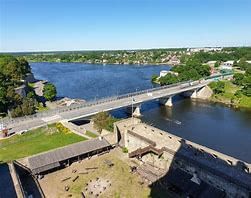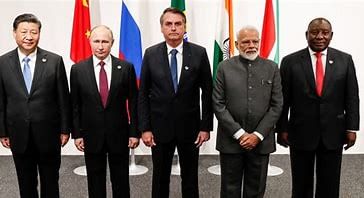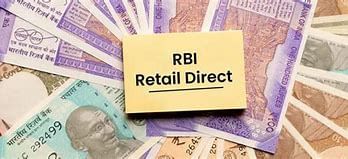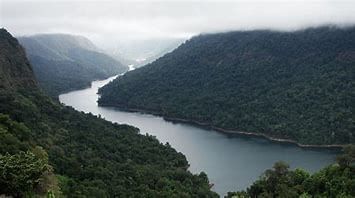UPSC Daily Current Affairs - 30th May 2024 | Current Affairs & Hindu Analysis: Daily, Weekly & Monthly PDF Download
GS-I/Geography
RUSSIA'S DISPUTE WITH ESTONIA OVER NARVA RIVER
Source: Financial Express
Why in news?
Recently, Russia's removal of navigation buoys on the Narva River has sparked concerns about border security, territorial integrity, and potential economic impacts on Estonia.
This move, following tensions with Ukraine, indicates Russia's strategic intentions and its stance towards Estonia and NATO.
Background of Dispute:
- Estonia and Russia are in a dispute over the Narva River, linked to the removal of navigation markers.
- The conflict between Ukraine and Russia has strained relations with neighboring nations.
About Estonia:
- Estonia is located in Northern Europe by the Baltic Sea.
- It shares borders with Finland, Sweden, Latvia, and Russia.
- Forced into the USSR in 1940, Estonia gained independence in 1991.
- It includes the mainland, islands like Saaremaa and Hiiumaa, and numerous islets.
- Key cities are Tallinn and Tartu.
- Estonia is a developed country with a high-income economy and a small population.
Narva River and Recent Events:
- The Narva River flows into the Baltic Sea and forms part of the Estonia-Russia border.
- Russia removed 24 navigation buoys post-Ukraine conflict, raising concerns about border security.
- This action could disrupt Estonia's shipping route, impacting its economy.
- Russia's move may be perceived as a strategic attempt to intimidate Estonia and its NATO allies.
GS-III/Economy
CERTIFICATE OF DEPOSIT
Source: CNN

Why in News?
Banks resorted to issuing certificates of deposit (CDs) in the financial year 2023-2024 due to tight liquidity conditions and sluggish deposit growth.
- CD issuance surged by 31% compared to the previous year, reflecting a strategy to mobilize funds.
Background:
- Banks witnessed a year-on-year deposit growth of 13.1% until March 8, lower than the credit growth of 16.5%.
- Excluding the impact of the HDFC-HDFC Bank merger, the deposit growth rate was affected.
About Certificate of Deposit
- A CD represents a contractual agreement between depositors and approved financial entities.
- Depositors lend money to banks in exchange for interest over a specified period.
- Upon maturity, depositors can redeem their funds.
- CDs are issued in dematerialized form and are regulated by the Reserve Bank of India (RBI).
Entities Authorized to Issue CDs:
- Scheduled Commercial Banks
- Regional Rural Banks
- Small Finance Banks
- Select All-India Financial Institutions approved by the RBI
Features of Certificate of Deposit:
- CDs can be issued at a discount or as coupon-bearing instruments.
- Minimum denomination for banks is ₹5 lakh, with a tenor not exceeding one year.
- Financial Institutions can issue CDs for 1 to 3 years, fully taxable under the Income Tax Act.
- Loans against CDs are not permitted unless authorized by the RBI.
GS-II/International Relations
EXPANSION OF BRICS
Source: Business Standard

Why in News?
BRICS expanded on January 1, 2024, adding Egypt, Ethiopia, Iran, Saudi Arabia, and the United Arab Emirates.
- BRICS now comprises 10 nations, enhancing its economic and demographic influence.
- Argentina was also slated to join but later withdrew under new leadership.
Significance of Expansion
- Alignment of geopolitical and economic interests within BRICS.
- Integration of major oil producers near vital trade routes.
- Promotion of new economic and people-to-people connections.
- Strengthening African integration efforts through new member inclusions.
- Boost to BRICS from major Middle Eastern players.
- Potential to drive reforms in the global multilateral system.
Challenges and Issues
- Rapid expansion risks diluting BRICS' original objectives.
- Concerns over China's dominant role and motives within the bloc.
- Increased complexities for India in balancing various international groupings.
- Potential for internal tensions impacting BRICS operations.
- Lack of transparent membership criteria.
- Challenges in intra-BRICS trade due to sanctions and financial systems.
- Rise of "minilateralism" and its implications for global cooperation.
Way Forward for India
- Strategic balancing of ties with Western powers and BRICS members.
- Leveraging expanded BRICS for advancing Indian interests.
- Enhanced collaboration opportunities for India within BRICS.
- Promoting intra-BRICS trade in national currencies to bolster regional economic ties.
- Benefits for India in energy diversification and pricing through expanded BRICS.
- Advocating for clear membership criteria to address future concerns.
GS-III/Science and Technology
DJIBOUTI RELEASES GM MOSQUITOES TO FIGHT MALARIA
Source: BBC
Why in News?
Genetically modified (GMO) mosquitoes were released in Djibouti, East Africa on May 23, 2024 to combat malaria. This marks the first release of genetically engineered mosquitoes in East Africa and the second in Africa, following Burkina Faso in West Africa.
Key Takeaways
- The release is part of the ‘Djibouti Friendly Mosquito Programme’ initiated two years ago to halt the spread of Anopheles stephensi, an invasive mosquito species.
- In 2012, Djibouti recorded 27 malaria cases when Anopheles stephensi was first identified in Africa. By 2020, the malaria caseload had surged to 73,000 cases.
- Anopheles stephensi, a highly invasive mosquito originating from South Asia and the Arabian Peninsula, has spread to other African countries like Ethiopia, Sudan, Somalia, and Nigeria.
- Unlike typical malaria-carrying mosquitoes in rural areas, Anopheles stephensi thrives in urban settings, posing a significant threat to Djibouti's urban population, where 70% reside in the capital and are exposed to the malaria vector.
- Oxitec, a biotech firm, developed a method using genetically modified male mosquitoes carrying a gene that hinders their female offspring from maturing. This strategy aims to reduce the female mosquito population, crucial for malaria transmission.
- The self-limiting gene in the modified mosquitoes ensures that only male offspring survive, leading to a decline in the mosquito population over time.
- By targeting female mosquitoes, which transmit malaria, scientists anticipate a substantial decrease in disease transmission, as male mosquitoes do not transmit malaria.
About Malaria
- Malaria, caused by a parasite transmitted through infected mosquitoes, particularly Anopheles species, affects humans worldwide.
- Female Anopheles mosquitoes transmit malaria by biting infected individuals and passing on the parasite to others they subsequently bite, perpetuating the disease cycle.
- Among the five Plasmodium parasite species causing malaria in humans, P. falciparum and P. vivax pose the greatest threats.
GS-II/Polity and Governance
Dispelling Population Myths Triggered by a Working Paper
Source: The Hindu

Why in News?
The working paper released by the Economic Advisory Council (EAC) to the Prime Minister makes an erroneous assertion regarding the growth of the Muslim population.
Content:
Composition of the Population of Various Communities Highlighted by EAC:
- The Hindu population grew by 701 million while the Muslim population increased by 146 million.
- The proportion of Hindus in the population fell by 6.64 percentage points from 1950 to 2015, while the proportion of Muslims increased by 4.25 percentage points.
- The Muslim population remains significantly smaller compared to the Hindu population despite these changes.
2011 Census Insights:
- In 2011, the proportion of the Hindu population to the total population declined by 0.7 percentage points.
- The proportion of the Sikh and Buddhist populations also declined during the decade 2001-2011.
- The proportion of the Muslim population to the total population increased by 0.8 percentage points.
Issue of Misinterpretation and Sensationalism of Data:
- Media reports and politicians have sensationalized the findings inaccurately suggesting rapid Muslim population growth, contributing to a divisive political narrative.
- Such interpretations misinform the public about population issues.
Influence of Socio-Economic Factors:
- Population growth is influenced by socio-economic conditions like education and healthcare rather than just religious factors.
- Higher fertility rates often reflect lower levels of socio-economic development.
Policies and Development Indicators:
- The Muslim community's higher population growth rate is attributed to lagging in certain socio-economic development indicators compared to the Hindu community.
Need for Exact Data:
- Detailed analysis is crucial to avoid misinterpretation of demographic changes.
- Understanding demographic shifts requires considering socio-economic, cultural, and political factors.
Religious Composition and Fertility Rates:
- The proportion of India's major religious groups has remained stable since Partition.
- Recent surveys indicate significant declines in Muslim fertility rates.
Conclusion:
- Accurate and comprehensive analysis is essential to understand population trends and avoid divisive narratives.
Mains PYQ:
- Demographic Dividend in India requires a more educated, aware, skilled, and creative population.
- The government's measures to enhance population productivity and employability are crucial for realizing this potential.
GS-III/Environment and Ecology
Sharavathi River
Source: Times of India
Why in News?
The National Green Tribunal (NGT) has directed the State Environment Impact Assessment Authority (SEIAA) and the mines and geology department to stop any unlawful/illegal sand mining in the Sharavathi River coastal zone.
About National Green Tribunal (NGT)
- Description:
- Establishment: Formed in 2010 under the National Green Tribunal Act as a statutory body.
- Objective: To deal with cases related to environmental issues and ensure speedy implementation of decisions.
- Composition: Headquartered in Delhi, chaired by a retired Supreme Court judge, included Judicial Members and Expert Panel.
- Powers:
- Empowered to decide on questions related to various environmental laws and hear civil cases concerning environmental issues under various acts.
- Exceptions: Prohibited from hearing issues covered under certain acts like the Indian Forest Act and the Wildlife (Protection) Act.
- Places:
- Principal bench in Delhi; Additional benches in Bhopal, Pune, Kolkata, and Chennai.
- Governing Principles:
- Governed by principles of natural justice, applies principles of sustainable development, precautionary, and polluter pays.
- Jurisdiction:
- Jurisdiction over all civil cases involving a substantial question relating to the environment; decisions are binding.
- Disposal of Cases: Disposal of applications or appeals finally within 6 months of filing.
About Sharavathi River
- Geography and Length:
- The river originates at Ambutheertha in Thirthahalli taluk, Karnataka.
- The river stretches about 128 km and joins the Arabian Sea at Honnavar in Uttara Kannada district.
- Legend:
- According to ancient legend, the god Rama shot an arrow into the ground to quench his wife Sita's thirst, named the water "Thirtha," hence the river's name "Sharavati."
- Tributaries and Basin:
- Major tributaries: Nandihole, Haridravathi, Mavinahole, Hilkunji, Yennehole, Hurlihole, and Nagodihole.
- River basin divided between Uttara Kannada and Shimoga districts.
- Dams:
- Linganamakki Dam constructed in 1964, spans the Sharavati River; Gerusoppa Dam primarily serves for electricity generation.
- Flora and Fauna:
- Sharavati Valley Wildlife Sanctuary declared in 1972, protects diverse ecosystems and endangered species.
- Regulation of Sand Mining in India:
- Mines and Minerals Act, 1957: Defines sand as a minor mineral.
- State Governments' Role: Empowered to regulate mineral concessions for minor minerals.
- Sustainable Sand Mining Management Guidelines, 2016: Aims to promote scientific and environmentally friendly sand mining practices.
- Sand Mining Framework, 2018: Provides guidance for policy formulation and combating illegal sand mining.
GS-III/Economy
 |
Download the notes
UPSC Daily Current Affairs - 30th May 2024
|
Download as PDF |
RBI launches PRAVAAH, Retail Direct mobile app and FinTech Repository
Source: Money Control

Why in the News?
Recently, the Reserve Bank of India (RBI) has introduced three key initiatives to enhance regulatory processes, empower retail investors, and provide insights into the fintech sector.
PRAVAAH Portal:
The PRAVAAH portal (Platform for Application, Validation, and Authorisation) is a centralized web-based platform for individuals and entities to seek regulatory approvals from the RBI.
- Offers online application submission and status tracking.
- Covers 60 different application forms across various regulatory departments.
RBI Retail Direct Mobile App:
The RBI Retail Direct Mobile App provides retail investors with easy access to government securities (G-Secs) trading directly from their smartphones.
- Accessible on both Android and iOS platforms.
- Simplifies transactions in both primary and secondary markets.
FinTech Repository:
The FinTech Repository aims to offer comprehensive data on Indian fintech firms, aiding in regulatory understanding and policy formulation.
- Focuses on RBI-regulated entities' adoption of emerging technologies like AI, ML, Cloud Computing, and Quantum.
- Managed by the Reserve Bank Innovation Hub (RBIH) to foster innovation and collaboration in the financial sector.
Previous Year Question:
[2013] In the context of the Indian economy, 'Open Market Operations' refers to:
- (a) borrowing by scheduled banks from the RBI
- (b) lending by commercial banks to industry and trade
- (c) purchase and sale of government securities by the RBI
- (d) None of the above
GS-II/Governance
AMRUT Scheme
Source: The Hindu

Why in news?
By 2047, over 50% of India’s population will be urban. The AMRUT scheme, initiated in 2015 and revised in 2021, addresses urban infrastructure needs.
About
- Atal Mission for Rejuvenation and Urban Transformation - AMRUT:
- Flagship urban development scheme launched by the Government of India in June 2015.
- Operated as a Central Sponsored Scheme.
Aim and Objectives
- Aim:
- To provide basic urban infrastructure to enhance the quality of life in cities and towns.
- Objectives:
- Ensure access to tap water and sewerage connections for every household.
- Increase green areas in cities.
- Promote public transport to reduce pollution.
Funding and Coverage
- Funding:
- Divided among States/UTs with a 50:50 weightage formula.
- Coverage:
- Includes 500 cities, comprising all cities and towns with a population exceeding one lakh with notified Municipalities.
Revenue Set Aside
- AMRUT 1.0:
- Total outlay was ₹50,000 crore for five years from FY 2015-16 to FY 2019-20.
- AMRUT 2.0:
- Total outlay is ₹2,99,000 crore, with a central outlay of ₹76,760 crore for five years, commencing from October 1, 2021.
Achievements
- Financial Utilization:
- As of May 19, 2024, a total of ₹83,357 crore has been disbursed under the AMRUT scheme, combining contributions from the Central Government, States, and cities.
- Infrastructure Achievements:
- Tap Connections: 58,66,237 households provided with tap connections for reliable water supply.
- Sewerage Connections: 37,49,467 households connected to the sewerage system, enhancing sanitation.
- Parks Development: 2,411 parks developed, improving urban green spaces.
- LED Street Lights: 62,78,571 LED street lights replaced, enhancing energy efficiency.
Challenges and Shortcomings
- Present Challenges:
- Public health crisis due to inadequate water, sanitation, and hygiene.
- Water and sanitation issues leading to significant public health problems.
- Causes for the Present Shortcomings:
- Non-comprehensive approach in urban planning.
- Inadequate water management and urban planning dominated by real estate interests.
Way Forward
- Approach:
- Transition from project-oriented to holistic urban planning.
- Actions:
- Enhance city participation in planning and implementation.
- Integrate nature-based solutions for sustainable urban development.
- Emphasize water, sanitation, and hygiene infrastructure improvements for public health.
Conclusion
- The balanced approach encompassing holistic urban planning, city participation, nature-based solutions, climate-responsive strategies, and public health focus is crucial for sustainable urban development.
Main Question
Major cities in India are increasingly vulnerable to flood conditions. Discuss.
GS-III/Science and Technology
GOLDEN RICE
Source: The National News

Why in News?
A court in the Philippines has recently revoked biosafety permits for the commercial propagation of genetically modified golden rice and Bt eggplant.
- Significance of the Decision: This decision has garnered international attention as supporters of GM crops argue that it could have adverse effects on children suffering from vitamin A deficiency. However, the court highlighted safety violations.
- About Golden Rice:
- Nutrient Content: Golden Rice is a novel variety of rice enriched with beta carotene, a precursor of vitamin A, giving it a yellow-orange or golden hue.
- Genetic Modification: Scientists used genetic engineering to introduce beta carotene into rice grains, enhancing their nutritional value.
- Source of Beta Carotene: The beta carotene in Golden Rice, facilitated by two new enzymes, mirrors that found in various vegetables, fruits, and supplements.
- Cultivation and Yield: Similar to regular rice, Golden Rice can be cultivated conventionally and demonstrates comparable yield and agronomic performance.
- Addressing Vitamin A Deficiency:
- Challenges Faced: While vitamin A can be sourced from various food items and supplements, issues such as availability, accessibility, and affordability hinder its effective distribution.
- Role of Golden Rice: Given that rice is a staple in many vitamin A-deficient regions, Golden Rice could play a pivotal role in ameliorating vitamin A deficiency once it is widely accessible.
- International Rice Research Institute: The institute involved in the development of Golden Rice and other innovative rice varieties to address nutritional deficiencies.
GS-III/Science and Technology
Open access is crucial for self-reliance in science
Source: The Hindu
Why in the News?
As per "Nature Index", India’s scientific prowess is rising but lacks essential research infrastructure.
- Initiatives like I-STEM aim to bridge this gap by democratizing access to advanced facilities.
The Indian Science Ecosystem:
- Growth in Research:
- India ranks third globally in research output and eleventh in research quality according to the “Nature Index”.
- Infrastructure Shortfalls:
- Despite an increase in the number of universities from 760 in 2014 to 1,113 in 2021, many lack essential resources such as advanced labs, instrumental access, and research literature.
Why is the Open Access Crucial for Self-Reliance in Science?
- Open Access (OA) ensures that scientific knowledge is freely available to all, regardless of geographical or financial barriers.
- It promotes inclusivity and allows researchers from diverse backgrounds to access the latest research findings, fostering collaboration and innovation.
Initiatives to Address Gaps:
- I-STEM:
- Catalogues all publicly funded research facilities nationwide and makes them available to researchers based on need.
- One Nation, One Subscription (ONOS):
- Proposes a centralized model of subscription to scientific journals to make them universally available to all publicly funded institutions, addressing the high cost of accessing commercial journals.
What is the Optimal Solution?
- The optimal solution lies in prioritizing initiatives. With a global shift towards OA and increasing mandates from major funding bodies, India should leverage this trend to reduce dependency on costly subscriptions and ensure widespread access to scientific literature.
- Major funding bodies and countries are pushing for OA, with the U.S. mandating immediate open accessibility of publicly funded research by 2025.
Challenges with ONOS:
- The high cost and oligopolistic academic publishing market make negotiation difficult. OA reduces the necessity of a costly unified subscription. ONOS does not ensure long-term access or global accessibility of Indian research.
The Green Open Access:
- Green Open Access allows authors to deposit a version of their work in a university repository, making it freely accessible globally. Ensures long-term preservation and accessibility of research funded by taxpayer money.
- Limitations:
- Indian funding agencies have mandated green OA, but it has not been enforced effectively.
- Recent issues should catalyze a stronger push for green OA.
Conclusion:
- India should enhance its journal system, avoiding payment burdens on authors or readers. Utilise digital technology capabilities to create and share low-cost, high-quality scientific publishing infrastructure for the global south.
Mains PYQ:
- India’s Traditional Knowledge Digital Library (TKDL) which has a database containing formatted information on more than 2 million medicinal formulations is proving a powerful weapon in the country’s fight against erroneous patents. Discuss the pro and cons of making the database available publicly available under open-source licensing. (UPSC IAS/2015)
|
39 videos|4566 docs|979 tests
|
FAQs on UPSC Daily Current Affairs - 30th May 2024 - Current Affairs & Hindu Analysis: Daily, Weekly & Monthly
| 1. What is the significance of the dispute between Russia and Estonia over the Narva River? |  |
| 2. How does the release of GM mosquitoes in Djibouti aim to fight malaria? |  |
| 3. What is the AMRUT Scheme and what does it aim to achieve? |  |
| 4. What is the significance of the launch of the PRAVAAH mobile app by RBI? |  |
| 5. How does the concept of open access contribute to self-reliance in science? |  |




























